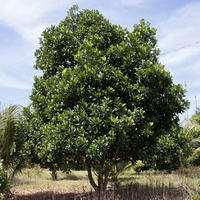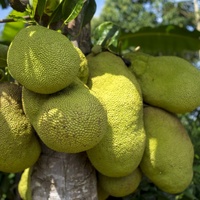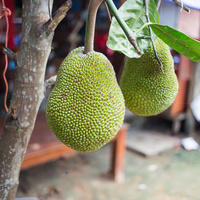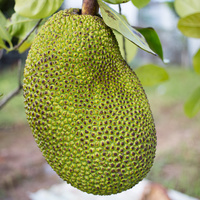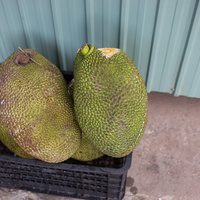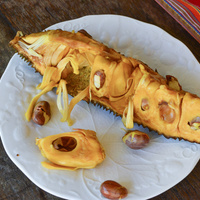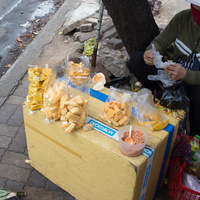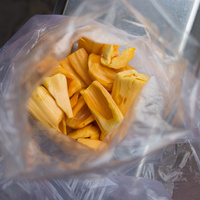Common name: Jackfruit
Other common names: Jack, Jak
Description
Jackfruit is believed to originate in the rainforests of the Southern Ghats, a mountain range situated in southwest India. From there, it was introduced to other tropical and subtropical regions of the world and is today perhaps the most widespread of the Artocarpus, a family of fruiting trees that includes the Breadfruit (Artocarpus altilis) and Marang (Artocarpus odoratissimus).
A medium-sized tree, it is typically 10 to 20 m (32 to 65 ft) tall with a straight, stout trunk supporting a densely branched crown, in young trees pyramidal-shaped, with age becoming more wide-spreading. The bark is dark grey, often mottled, and on wounding yields a sticky white latex, as do all other parts of the tree.
Leaves are large, up to 23 cm (9 in) long, deeply lobed on seedlings, changing to oval-shaped on mature trees, thick, leathery and dark glossy green. They remain on the tree in all seasons, and their dense arrangement casts a deep shade.
Flowers are small and insignificant, held in tightly-packed, club-shaped clusters of male or female flowers on the same tree but on different parts of the tree. The male clusters are borne on new wood near the ends of the branches and above the female clusters, which arise on old wood, mainly on the bottom branches, the trunk and sometimes on the exposed roots.
Fertilised flowers develop into very large, oblong or pear-shaped fruit with thick, rough, warty green rind. The world's largest fruit, they range in length from 30 to 90 cm (1 to 3 ft) and typically weigh from 5 to 25 kg (11 to 50 lbs), though they may weigh up to 50 kg (110 lbs) and hang on strong stalks from the lower branches and trunk.
Beneath the rind is a fibrous central core, around which radiate numerous, sizeable oblong seed, each embedded in the cavity of a bulb-shaped segment of firm, yellow to orange coloured pulp. There may be hundreds of seed in a single giant fruit. As the fruit matures, the rind becomes brownish-yellow, and the whole fruit gives off a strongly musky aroma, indicating its ripeness.
There are many varieties of Jackfruit, based on fruit shape and size, pulp colour and flavour, time to the start of bearing and time to maturity of the fruit. Still, they are generally divided into two main types, those with soft pulp and those with crisp pulp.
Use
The pulp is sweet, rich and fragrant, with a ripe banana-pineapple flavour and a soft or crunchy texture. It is mostly eaten fresh out-of-hand or added to fruit salads. Its low water content also makes it able to be deep-fried to make chips or crisps, now a popular packaged and branded snack food. The ripe pulp can also be used to flavour ice cream and to make chutney, jam and jelly.
Wine is also made from the ripe pulp, first by pureeing it then adding boiled water, sugar, a cinnamon stick and yeast. This mixture is then poured into an earthenware container, covered with a cloth and lid, and allowed to sit for about two weeks to ferment. After fermentation, the liquid is strained into sterilised bottles. The resulting wine has an alcohol content of about 8% and is mildly acidic with a fruity taste. Only the ripe pulp is used in the process. The central core and fleshy strands connecting the segments usually being discarded along with the rind.
The pulp of green or unripe Jackfruit is commonly used in South India and Caribbean vegetable curries. Because the pulp appearance and texture is similar to that of lobster meat, it is often referred to as mock-lobster curry. To prepare the curry, young or unripe fruit are cut into pieces and boiled until soft, and they are then left to cool before the pulp is extracted and shredded. The soft, shredded pieces are then added to a coconut curry near the end of the cooking process. In Western cuisine, the shredded pulp is more often used as a pulled-pork substitute.
The large seed are also edible and are usually boiled or roasted before eating. They are said to have a texture and taste similar to chestnuts. They can also be made into gluten-free flour used in baking when mixed with other flours.
The milky latex, when heated, can be used as glue to mend broken crockery. It is also a reasonable substitute for chicle, used for chewing gum. The principal source of which is the Sapodilla tree (Manilkara zapota).
The young leaves are palatable to livestock and have a crude protein content of around 15% of their dry weight.
Jackfruit trees are known to withstand hurricane-force winds, making them an excellent choice for a windbreak.
Health use
The fruit pulp contains high levels of Vitamins A, B1 (Thiamine), B2 (Riboflavin), B3 (Niacin), and C.
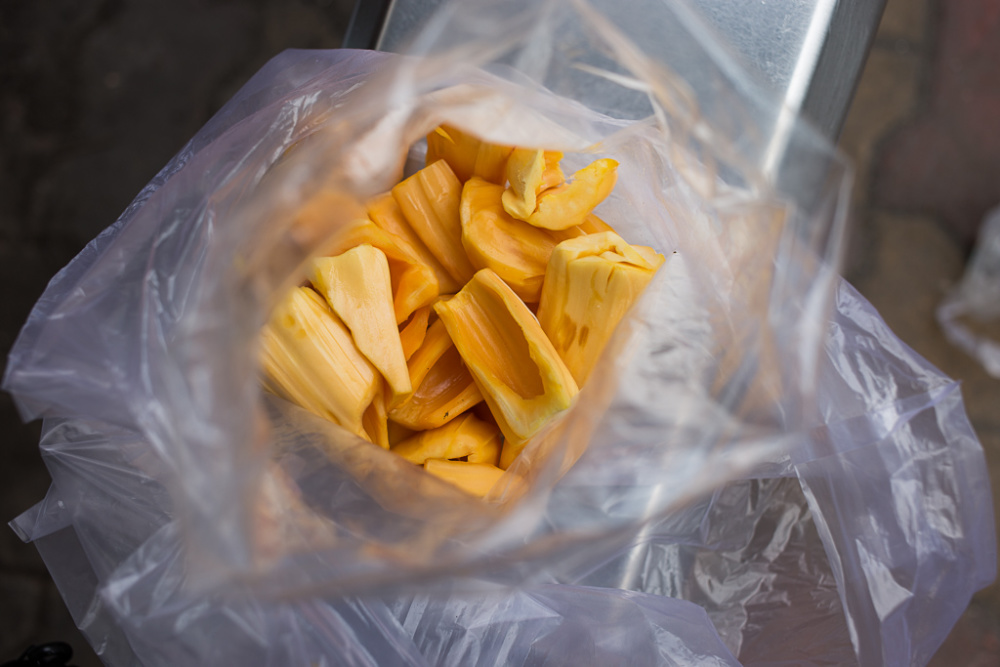
Jackfruit segments
Climate
Jackfruit grows naturally and produces flavoursome fruit in humid subtropical and tropical climates, generally frost-free areas with annual lows of 15 to 25°C, annual highs of 24 to 35°C, annual rainfall of 1200 to 4500 mm and a dry season of 5 months or less, extending to 9 months with irrigation.
In southern India, Jackfruit trees produce flavoursome fruit at elevations from near sea level up 1300 m (4300 ft), in areas where the average low of the warmest month is 18°C (64°F) or higher. At higher elevations, the fruit are of poor quality and mostly only suitable for cooking.
Growing
New plants can be started from seed, but seedlings do not come true-to-type, so vegetative propagation is preferred when cultivating selected varieties. Air-layering (circumposing) and grafting selected varieties onto seedling rootstock are the propagation techniques used mostly by professional horticulturists. When transplanting seedlings, care should be taken not to damage or bend the long taproot.
Jackfruit trees perform best on fertile, free-draining clay-loam, loam, sand-loam and loamy-sand soils of a moderately acid to slightly alkaline nature, generally with a pH of 5.0 to 8.0, and on sites with full to partial sun exposure.
A Jackfruit tree can produce up to 250 fruit per year and, with an average weight of 15 kg (33 lbs), has the potential to produce 3,750 kg (8,267 lbs) of fruit.
Jackfruit trees perform best on fertile, free-draining clay-loam, loam, sand-loam and loamy-sand soils of a moderately acid to slightly alkaline nature, generally with a pH of 5.0 to 8.0, and on sites with full to partial sun exposure.
A Jackfruit tree can produce up to 250 fruit per year and, with an average weight of 15 kg (33 lbs), has the potential to produce 3,750 kg (8,267 lbs) of fruit.
Problem features
Jackfruit is assessed as a low weed risk species for Hawaii and Florida, respectively, by the Hawaii Pacific Weed Risk Assessment (HPWRA) project and the IFAS Assessment of Non-Native Plants in Florida's Natural Areas.
Where it grows
References
Books
-
Adams, C. D. 1972, Flowering plants of Jamaica, University of the West Indies, Mona, Greater Kingston
-
Allen, B. M. 1967, Malayan fruits : an introduction to the cultivated species, Donald Moore Press, Singapore
-
Attokaran, M. 2011, Natural food flavors and colorants, Institute of Food Technologists, Wiley-Blackwell Publishing, Oxfordshire
-
Bladholm, L. 1999, The Asian grocery store demystified, 1st edition, Renaissance Books, Los Angeles, California
-
Elevitch, C. R. 2006, Traditional trees of Pacific Islands: their culture, environment and use, 1st edition, Permanent Agriculture Resources, Holualoa, Hawaii
-
Francis, J. K. and Liogier, H. A. 1991, Naturalized exotic tree species in Puerto Rico, General technical report SO-82, USDA Forest Service, Southern Forest Experiment Station, New Orleans
-
Howes, F. N. 1949, Vegetable gums and resins, Chronica Botanica Company, Waltham, Massachusetts
-
Jensen, M. 1999, Trees commonly cultivated in Southeast Asia : an illustrated field guide, 2nd ed., Food and Agricultural Organisation of the United Nations (FAO) Regional Office for Asia and the Pacific (RAP), Bangkok
-
Krishen, P. 2006, Trees of Delhi : a field guide, Dorling Kindersley Publishers, Delhi
-
Letourneux, C. 1957, Tree planting practices in tropical Asia, Food and Agriculture Organization of the United Nations (FAO), Rome
-
Luna, R. K 1996, Plantation trees, International Book Distributors, Dehradun, Uttarakhand
-
Martin, F. M., et al. 1987, Perennial edible fruits of the tropics : an inventory, U.S. Dept. of Agriculture (USDA), Agricultural Research Service, U.S. Government Printing Office (GPO), Washington, D.C.
-
Mollison, B. 1993, The permaculture book of ferment and human nutrition, Tagari Publications, Tyalgum, New South Wales
-
Morton, J. F. & Dowling, C. F. 1987, Fruits of warm climates, Creative Resources Systems, Winterville, North Carolina
-
Parrotta, J. A. 2001, Healing plants of peninsular India, CABI Publishing, Wallingford, Oxfordshire
-
Queensland Department of Primary Industries and Fisheries (QLD DPI) 2008, Queensland tropical fruit : the healthy flavours of North Queensland, Brisbane
-
Rosengarten, F. 1984, The book of edible nuts, Walker and Company Publishing, New York
-
Scheffer, T. C & Morrell, J. J. 1998, Natural durability of wood : a worldwide checklist of species, Forest Research Laboratory, Oregon State University, Corvallis, Oregon
-
Selvam, V. 2007, Trees and shrubs of the Maldives, Food and Agriculture Organisation (FAO) RAP publication (Maldives), Thammada Press Company Ltd., Bangkok
-
Singh, R. V. 1982, Fodder trees of India, Oxford & IBH Publishing Company, New Delhi
-
Stewart, A. 2013, The drunken botanist : the plants that create the world's great drinks, 1st ed., Algonquin Books, Chapel Hill, North Carolina
Articles, Journals, Reports and Working Papers
-
Watson, B.J., & Moncur, M. 1985, Guideline criteria for determining survival, commercial and best mean minimum July temperatures for various tropical fruit in Australia (Southern Hemisphere), Department of Primary Industries Queensland (DPI QLD), Wet Tropics Regional Publication, Queensland
